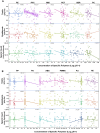Microplastic presence in dog and human testis and its potential association with sperm count and weights of testis and epididymis
- PMID: 38745431
- PMCID: PMC11285152
- DOI: 10.1093/toxsci/kfae060
Microplastic presence in dog and human testis and its potential association with sperm count and weights of testis and epididymis
Abstract
The ubiquitous existence of microplastics and nanoplastics raises concerns about their potential impact on the human reproductive system. Limited data exists on microplastics within the human reproductive system and their potential consequences on sperm quality. Our objectives were to quantify and characterize the prevalence and composition of microplastics within both canine and human testes and investigate potential associations with the sperm count, and weights of testis and epididymis. Using advanced sensitive pyrolysis-gas chromatography/mass spectrometry, we quantified 12 types of microplastics within 47 canine and 23 human testes. Data on reproductive organ weights, and sperm count in dogs were collected. Statistical analyses, including descriptive analysis, correlational analysis, and multivariate linear regression analyses were applied to investigate the association of microplastics with reproductive functions. Our study revealed the presence of microplastics in all canine and human testes, with significant inter-individual variability. Mean total microplastic levels were 122.63 µg/g in dogs and 328.44 µg/g in humans. Both humans and canines exhibit relatively similar proportions of the major polymer types, with PE being dominant. Furthermore, a negative correlation between specific polymers such as PVC and PET and the normalized weight of the testis was observed. These findings highlight the pervasive presence of microplastics in the male reproductive system in both canine and human testes, with potential consequences on male fertility.
Keywords: male reproductive; particulates; polymers; pyrolysis GC/MS; sperm count; testis.
© The Author(s) 2024. Published by Oxford University Press on behalf of the Society of Toxicology. All rights reserved. For permissions, please e-mail: journals.permissions@oup.com.
Figures




References
-
- Chen X., Cao S., Wen D., Geng Y., Duan X. (2022). Sentinel animals for monitoring the environmental lead exposure: Combination of traditional review and visualization analysis. Environ. Geochem. Health. 45, 561–584. - PubMed
-
- Creasy D. M. (2003). Evaluation of testicular toxicology: A synopsis and discussion of the recommendations proposed by the Society of Toxicologic Pathology. Birth Defects Res. B Dev. Reprod. Toxicol. 68, 408–415. - PubMed
-
- Garcia M. A. L. R., Nihart A., El Hayek E., Castillo E., Barrozo E. R., Suter M. A., Bleske B., Scott J., Forsythe K., Gonzalez-Estrella J., et al. (2024). Quantitation and identification of microplastics accumulation in human placental specimens using pyrolysis gas chromatography mass spectrometry. Toxicol. Sci. 199, 81–88. - PMC - PubMed
MeSH terms
Substances
Grants and funding
LinkOut - more resources
Full Text Sources
Miscellaneous

